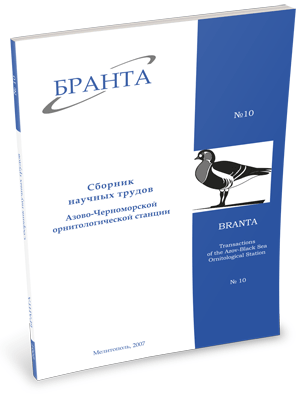
Transactions
of the Azov-Black Sea Ornithological Station



Towards southern borders of distribution of some elements of breeding ornithofauna of the plains and foothills of the Crimea
Beskaravayny M.M.
Over the recent decades the Crimean ornithofauna has been essentially changing both its composition and range borders. This investigation is aimed at defining more precisely the borders of distribution of those bird species in the South Crimea, which major part of the range includes plains and foothills.
Material and methods
The main material was collected during 1988-2007. Investigations covered the region from Cape Khersones to Cape Chauda, including mountainous and partly flat part of the Crimea. The number of hydrophilic birds at water bodies was estimated by direct count of pairs and broods (64 counts). There were precisely investigated 55 water bodies, located in western and eastern foothills, in the east of southern coast and on Akmonaysky Isthmus. Number of species in land habitats was estimated by route and point counts (60 counts). There were surveyed the southern coast, the Main Ridge (yailas), and northern foothills. The breeding was also proved by nest founds, meetings o f broods and observations o f birds with breeding material; it was also proved (with relevant reservations) by facts indirectly showing the presence o f nests: regular observations of pairs in breeding habitats, singing males, alerting birds or birds with forage).
Species of tree-shrub habitats and open areas
Open areas (steppes, fallow lands) predominate in the south of Akmonaysky Isthmus and Gerakleysky Peninsula. Tree vegetation, located there, is of anthropogenic origin (forest belts, cottage orchards). Steppe communities spread over into the east of southern coast to Sudak and partly to the neighbourhood of the village Privetnoye. Natural tree-shrub habitats (open woodlands of the oak and juniper) are distributed along the southern coast and in the northern foothills. Over the last years southern borders o f ranges were much more accurately defined for 22 species: Buteo rufinus, Falco vespertinus, Perdix perdix, Coturnix coturnix, Anthropoides virgo, Asio flammeus, Athene noctua, Dendrocopos syriacus, Coracias garrulus, Merops apiaster, Calandrella cinerea, Melanocorypha calandra, Anthus campestris, Motacilla feldegg, Lanius minor, Corvus monedula, Corvus frugilegus, Oenanthe oenanthe, Oenanthe pleschanka, Emberiza calandra, Emberiza melanocephala, Emberiza citrinella. At least 7 species reach the southern part o f Gerakleysky Peninsula and the west of the southern coast, 18 species spread to the south-eastern coast. Development o f the artificial tree-shrub vegetation created conditions for distribution of the Red-footed Falcon, Syrian Woodpecker, Lesser Grey Shrike, Rook and Jackdaw.
Conclusion
There were specified the borders of ranges of 41 bird species, typical for the plains and foothills of the Crimea. It was proved that ranges of majority of those species expand out the limits of the above-mentioned landscape-geographical zones, reaching the south of Gerakleysky Peninsula and the southern coast. In a number o f cases it is explained by recent years' tendency of expanding ranges (Great Cormorant, White Stork, Long-legged Buzzard, Syrian Woodpecker, Isabelline Wheatear, Black-headed Bunting). Distribution of many species is caused by the appearance of unoccupied ecological niches in the form o f anthropogenic landscape-habitat elements (artificial water bodies, tree plantations).
Read the paper in a PDF file